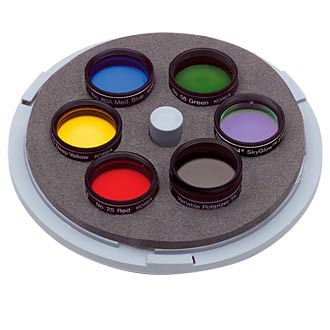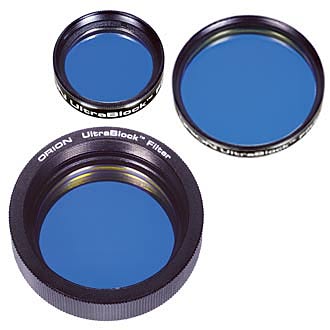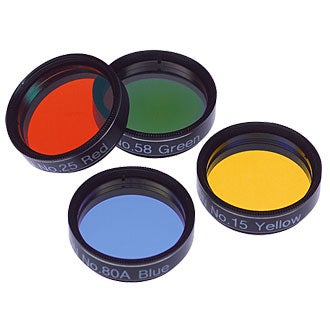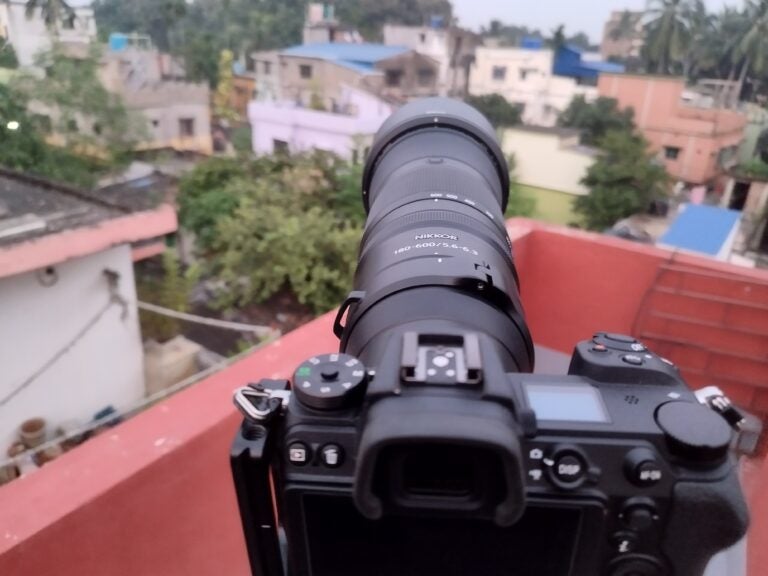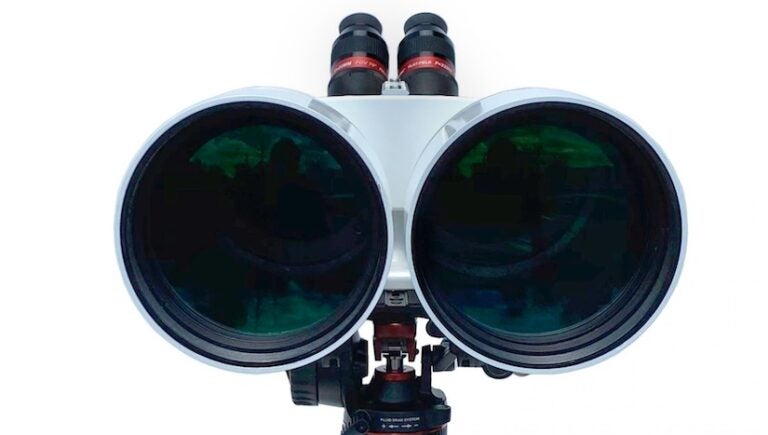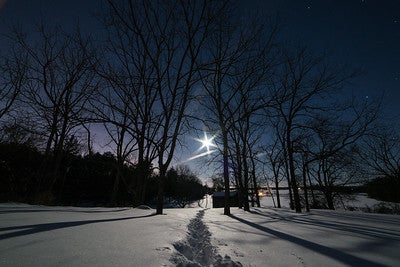Filters typically provide the best way to boost contrast. All filters work by transmitting light at certain wavelengths and blocking light at other wavelengths. Filters for astronomical observing come in three major flavors: nebula filters for deep-sky observing, planetary filters, and solar filters. Because they work by blocking light at some wavelengths, filters reduce the amount of light passing through the telescope and thus make the overall image dimmer. For some objects, however, the improvement in contrast can be enormous.
Most deep-sky observers swear by nebula filters, also called light-pollution-reduction (LPR) filters. At their most basic, they are designed to transmit emissions from nebulae while absorbing artificial light. In this day and age, when light pollution from nearby cities, towns, and even neighbors wreaks havoc on our view of the night sky, nebula filters have proven to be a godsend. Yet they also prove effective at bringing out faint detail at dark-sky sites. Because filters screw into the barrel of the eyepiece, be sure the ones you buy match the size of your eyepieces.
Most emission nebulae radiate a large portion of their energy in the green part of the spectrum, which also happens to be at the peak of the dark-adapted eye’s sensitivity. Fortunately, most light pollution occurs in the blue and yellow parts of the spectrum. A properly designed filter, then, can let almost all of a nebula’s light through while blocking most light pollution. This darkens the background sky significantly and sharply increases the contrast between object and sky.
Although all nebula filters operate on the same principle, they differ in how wide a range of wavelengths they let pass. Broadband filters — the ones most commonly billed as LPR filters — let the most light through and block the least. Typically, they transmit more than 90 percent of the green light in a wavelength band about 40 to 90 nanometers (nm) wide. Because they let through a fairly wide range of light, broadband filters don’t increase contrast as much as narrowband filters. Still, they provide a somewhat darker background sky that enhances the view of most objects — especially emission nebulae — from moderately light-polluted sites. Don’t expect dramatic results, however, if you observe from the heart of a city.
Narrowband filters are more discriminating, typically letting through light in the 20nm to 30nm range. The wavelength band coincides with the emission lines of hydrogen beta at 486.1nm and doubly ionized oxygen at 495.9nm and 500.7nm. These filters cut out most light-pollution lines as well as most of the continuous spectrum from stars and galaxies. So, they provide a nice dark background sky but prove of little use on objects other than emission and planetary nebulae. On those latter objects, however, narrowband filters boost the visual appearance dramatically.
The most extreme narrowband filters, sometimes referred to as line filters, let through light from only one or two emission lines. The OIII filter (or Oxygen III, which stands for doubly ionized oxygen) ranks in a class by itself. It effectively doubles the size of your telescope when it comes to observing emission and planetary nebulae. Bright nebulae look stunning even from the city, and the views under a rural sky are beyond compare. An OIII filter will make faint planetaries pop into view. The filter has only one drawback: It darkens stars so much — by two to three magnitudes — that it can be difficult to find the correct field at medium and high magnification.
The H-beta filter lets through only hydrogen-beta emission. Many observers have nicknamed it the “Horsehead filter” because it can pull in the elusive Horsehead Nebula in Orion even from moderately light-polluted sites. It also works wonders on the California Nebula in Perseus but, unfortunately, on precious few other objects. In most other cases, you’re better off with an OIII filter.
Color filters enhance subtle differences between adjacent regions on a planet’s surface or in its atmosphere. They prove particularly useful for only three planets, however: Mars, Jupiter, and Saturn. Mercury and Venus have essentially no features that can be observed from Earth, and Uranus and Neptune glow so dimly that filters only make them more difficult to see.
Planet observers use the Wratten series of color filters developed by Eastman Kodak for photography. The series contains more than 100 different hues, but don’t feel obligated to buy them all. A selection of four or five filters will get you going, and you can always add more for specific observing purposes. Although high-end camera stores carry Wratten filters, you’ll be better off getting ones that screw into eyepieces. As with nebula filters, be sure the filters have the same thread size as your eyepieces.
No object benefits more than Mars from the use of color filters. Even when Mars looms relatively large in the sky, as it did at its historic opposition in 2003 and will again in 2005, most martian details are elusive. Try an orange filter (W21 or W23A) to enhance the contrast between darker albedo features and brighter desert regions. These filters also help penetrate martian hazes and clouds. A red filter (W25 or W29) performs the same function, but it transmits less total light and thus doesn’t work as well with small or medium-size scopes. A green filter (W57) brings out frost patches and surface fogs while darkening red and blue features. A blue filter (W80A or W38) shows atmospheric clouds, limb hazes, and polar hoods. The best way to detect martian dust clouds or storms is to switch between an orange or red filter and a blue filter. If the region appears bright in red or orange and dim in blue, it’s dust.
If you observe Jupiter without a filter, likely the two dark equatorial belts will be the only features that stand out. Add a green (W57) or blue (W47) filter, however, and you can expect to pick up several additional bands. A yellow (W12 or W15) or orange (W21) filter will highlight the delicate loops and blue festoons that appear near the edges of the dark belts. Saturn’s atmosphere displays a similar banding to Jupiter’s — although more subtle — and the same filters do a good job on them.
Although solar filters operate on the same principle as nebula and planetary filters, their goal is different. With one notable exception, instead of enhancing certain features on the Sun’s surface, solar filters seek to diminish the total light coming from the Sun. The Sun shines so brightly that looking at it with the naked eye for more than a second can cause damage. Viewing it with any optical aid for even a fraction of a second risks permanent eye damage.
Three types of filter material work well for viewing the Sun. An inexpensive but safe filter for naked-eye observing is a #14 glass used by arc-welders. This dark green filter blocks all the Sun’s ultraviolet and infrared radiation and slashes the visible light by a factor of about 370,000. Be sure to get a #14 glass — those with lower numbers don’t filter out enough light.
For looking at the Sun through binoculars or a telescope, you’ll need either a metal-on-glass filter or a filter made of reflective polymer film. Both varieties block ultraviolet and infrared radiation while cutting visible light to acceptable levels. Be sure to get a filter that fits over the front end of your telescope or binoculars — you want to stop the light before it enters the optics. That’s why you never should use the so-called “Sun filter” that screws into the bottom of the eyepiece included with some small-aperture telescopes. The telescope’s lens or mirror still collects all the Sun’s radiation and focuses it near the eyepiece. The “filter” absorbs this intense heat and can crack, letting through the full power of the amplified sunlight and risking permanent blindness. If you own a telescope that comes with an eyepiece Sun filter, throw it away immediately so you’re never tempted to use it.
One type of specialty filter is designed to show details on the Sun. A hydrogen-alpha (or H-alpha) filter lets through light at a wavelength of 653.3nm and typically has a bandwidth of just 0.1nm or less. Manufactured to a high tolerance, these filters typically cost thousands of dollars. An H-alpha filter allows you to see details in and around sunspots; dark, sinuous filaments; bright plages; solar granulation; and prominences arching above the limb of the Sun. For those interested in daytime as well as nighttime observing, there’s no better accessory than an H-alpha filter.

